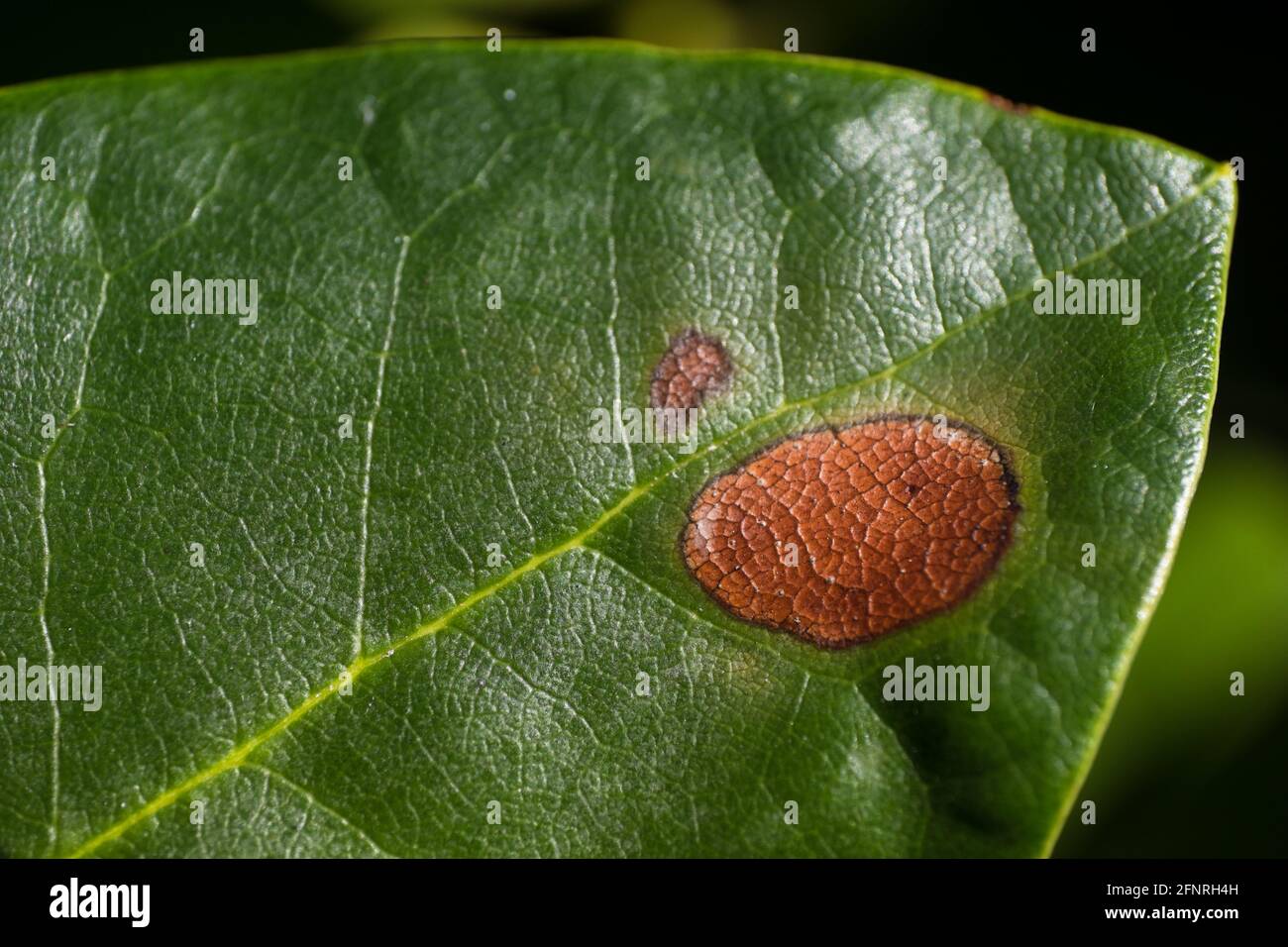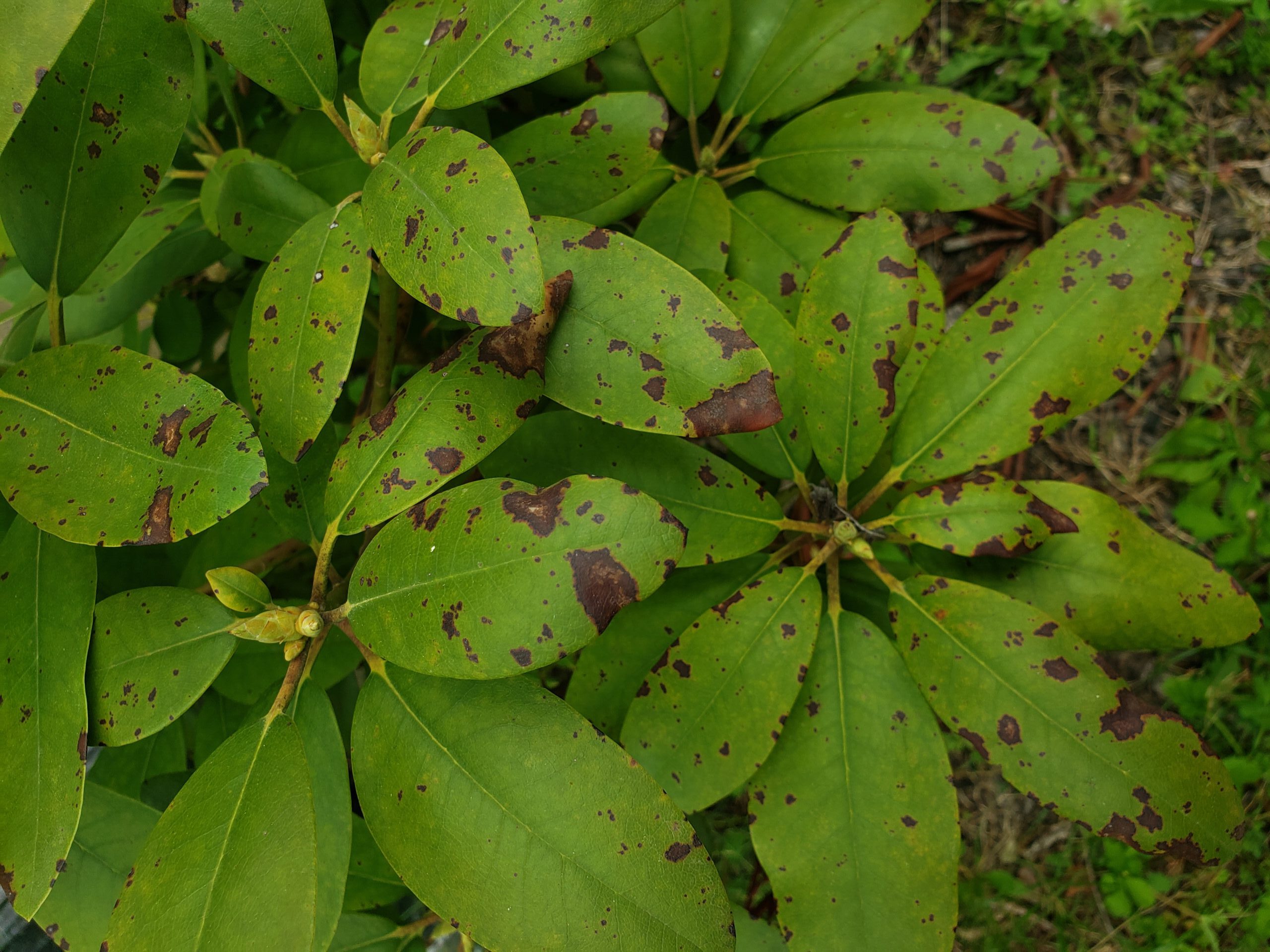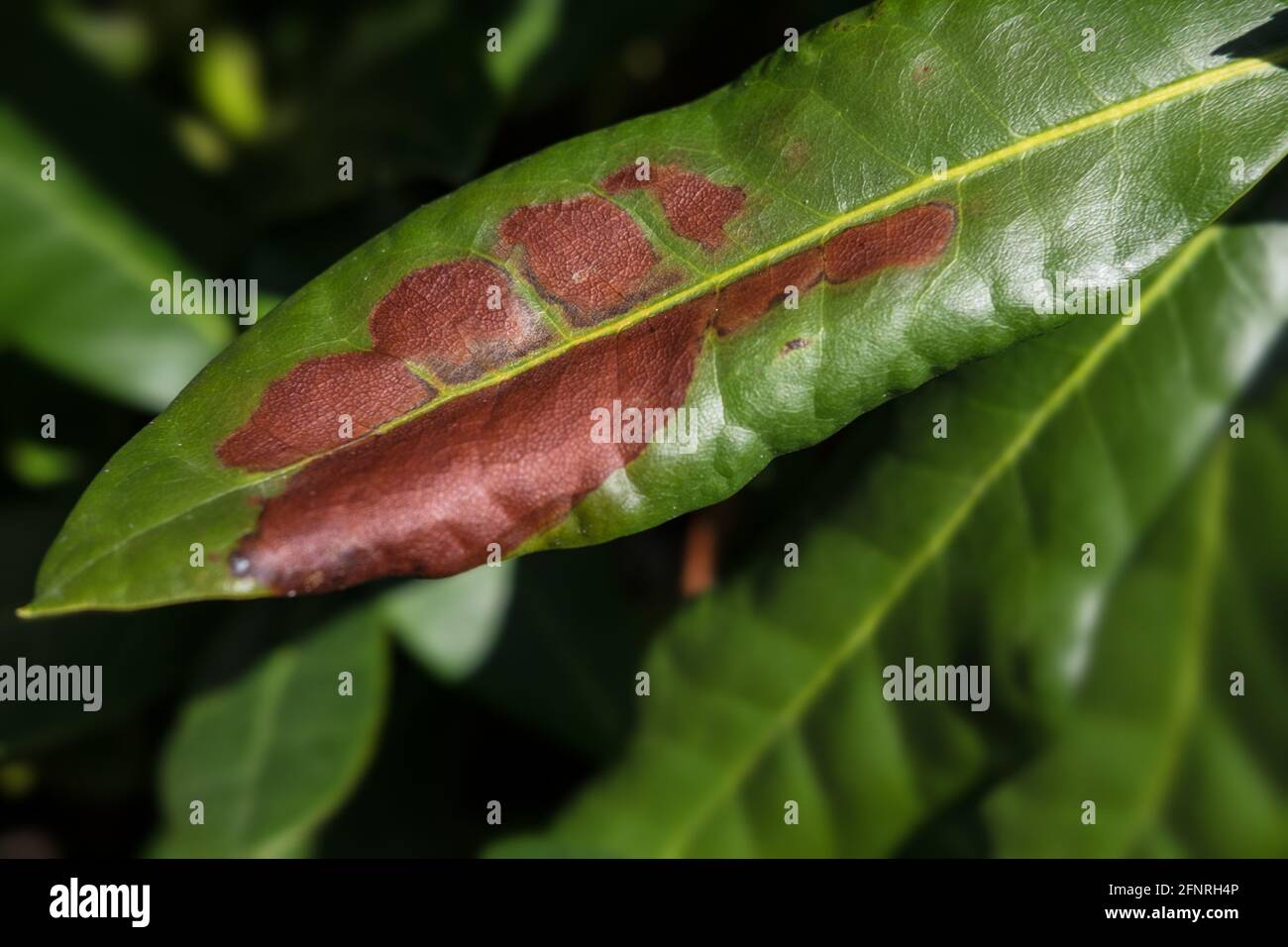What’s Behind the Brown Spots on Your Rhododendron Leaves?
Brown spots on rhododendron leaves are a common issue that can be caused by various factors, including fungal diseases, pests, and environmental stressors. Identifying the root cause of the problem is crucial for effective treatment. Rhododendron leaves are susceptible to a range of diseases and pests that can cause brown spots, making it essential to inspect the leaves carefully and take action promptly.
Fungal diseases, such as leaf spot and root rot, are common causes of brown spots on rhododendron leaves. These diseases can be spread through water, wind, or insects, and can cause significant damage to the plant if left untreated. Pests, such as aphids, whiteflies, and spider mites, can also cause brown spots on rhododendron leaves by sucking the sap from the leaves or transmitting diseases.
Environmental stressors, such as extreme temperatures, drought, and excessive watering, can also cause brown spots on rhododendron leaves. Rhododendrons prefer well-draining soil and partial shade, and can be sensitive to extreme weather conditions. When the plant is under stress, it can become more susceptible to disease and pests, leading to brown spots on the leaves.
It’s essential to note that brown spots on rhododendron leaves can be a symptom of a larger problem, rather than the problem itself. By identifying the underlying cause of the issue, you can take targeted action to treat the problem and prevent it from recurring. In the next section, we’ll provide a step-by-step guide on how to inspect your rhododendron leaves for signs of trouble.
How to Inspect Your Rhododendron Leaves for Signs of Trouble
Inspecting your rhododendron leaves regularly is crucial for early detection of potential problems. To inspect your leaves, start by gently removing any debris or dirt that may be accumulated on the surface. Use a soft-bristled brush or a clean cloth to wipe away any dirt or debris.
Next, examine the leaves carefully for any signs of disease or pests. Look for brown spots, yellowing, or blackening of the leaves, as these can be indicative of fungal diseases or pest infestations. Check for any unusual growths, such as powdery mildew or leaf spot, and inspect the underside of the leaves for any signs of pests, such as aphids or spider mites.
When inspecting your rhododendron leaves, pay particular attention to the edges and tips of the leaves, as these areas are often the first to show signs of trouble. Also, check the stems and branches for any signs of disease or pests, as these can spread quickly to the leaves.
It’s also important to inspect your rhododendron leaves at different times of the day and in different lighting conditions. Some problems may be more visible in certain lighting conditions, so it’s essential to inspect your leaves in a variety of settings.
By regularly inspecting your rhododendron leaves, you can catch potential problems early and take action to prevent them from spreading. This can help prevent brown spots on rhododendron leaves and keep your plant healthy and thriving.
In the next section, we’ll discuss the most common fungal diseases that affect rhododendron leaves, including leaf spot, root rot, and powdery mildew.
Fungal Diseases: A Common Cause of Brown Spots on Rhododendron Leaves
Fungal diseases are a common cause of brown spots on rhododendron leaves. These diseases can be spread through water, wind, or insects, and can cause significant damage to the plant if left untreated. In this section, we’ll discuss the most common fungal diseases that affect rhododendron leaves, including leaf spot, root rot, and powdery mildew.
Leaf spot is a fungal disease that causes small, circular brown spots to form on the leaves of rhododendron plants. The spots may be surrounded by a yellow ring, and can eventually merge to form larger patches. Leaf spot is caused by a variety of fungi, including Cercospora and Septoria. Treatment for leaf spot typically involves removing infected leaves and applying a fungicide to the affected area.
Root rot is a fungal disease that causes the roots of rhododendron plants to rot, leading to brown spots on the leaves. Root rot is often caused by overwatering, which can lead to a buildup of fungi in the soil. Treatment for root rot typically involves repotting the plant in well-draining soil and reducing watering.
Powdery mildew is a fungal disease that causes a white, powdery coating to form on the leaves of rhododendron plants. The coating can eventually turn brown, causing brown spots to form on the leaves. Powdery mildew is caused by a variety of fungi, including Erysiphe and Oidium. Treatment for powdery mildew typically involves applying a fungicide to the affected area and improving air circulation around the plant.
It’s essential to note that fungal diseases can be difficult to treat, and may require repeated applications of fungicides. However, by identifying the disease early and taking prompt action, you can help prevent brown spots on rhododendron leaves and keep your plant healthy and thriving.
In the next section, we’ll discuss the types of pests that can cause brown spots on rhododendron leaves, including aphids, whiteflies, and spider mites.
Pests That Can Cause Brown Spots on Rhododendron Leaves
Pests can also cause brown spots on rhododendron leaves, and it’s essential to identify and control them promptly to prevent further damage. In this section, we’ll discuss the types of pests that can cause brown spots on rhododendron leaves, including aphids, whiteflies, and spider mites.
Aphids are small, soft-bodied insects that feed on the sap of rhododendron leaves, causing brown spots to form. They can also transmit plant viruses, which can further damage the plant. To control aphids, use insecticidal soap or neem oil, and make sure to spray the undersides of the leaves where aphids tend to congregate.
Whiteflies are tiny, winged insects that feed on the sap of rhododendron leaves, causing brown spots to form. They can also transmit plant viruses, which can further damage the plant. To control whiteflies, use yellow sticky traps or insecticidal soap, and make sure to spray the undersides of the leaves where whiteflies tend to congregate.
Spider mites are tiny, spider-like insects that feed on the sap of rhododendron leaves, causing brown spots to form. They can also spin webs on the leaves, which can further damage the plant. To control spider mites, use insecticidal soap or neem oil, and make sure to spray the undersides of the leaves where spider mites tend to congregate.
It’s essential to note that pests can be difficult to control, and may require repeated applications of insecticides. However, by identifying the pest early and taking prompt action, you can help prevent brown spots on rhododendron leaves and keep your plant healthy and thriving.
In the next section, we’ll discuss how environmental stressors such as extreme temperatures, drought, and excessive watering can cause brown spots on rhododendron leaves, and offer advice on how to mitigate these stressors.
Environmental Stressors That Can Cause Brown Spots on Rhododendron Leaves
Environmental stressors can also cause brown spots on rhododendron leaves. Extreme temperatures, drought, and excessive watering can all contribute to the development of brown spots. In this section, we’ll discuss how to mitigate these stressors and prevent brown spots on rhododendron leaves.
Extreme temperatures can cause brown spots on rhododendron leaves by damaging the plant’s cells and disrupting its ability to photosynthesize. To mitigate extreme temperatures, provide your rhododendron with some protection from the sun, such as a shade cloth or a layer of mulch. You can also bring your rhododendron indoors during periods of extreme cold or heat.
Drought can also cause brown spots on rhododendron leaves by depriving the plant of the water it needs to survive. To prevent drought, make sure to water your rhododendron regularly, but avoid overwatering, which can also cause brown spots. Check the soil moisture by inserting your finger into the soil up to the first knuckle. If the soil feels dry, it’s time to water.
Excessive watering can also cause brown spots on rhododendron leaves by causing the roots to rot. To prevent excessive watering, make sure to check the soil moisture before watering, and avoid getting water on the leaves or crown of the plant. You can also improve drainage by adding organic matter such as compost or perlite to the soil.
By mitigating environmental stressors, you can help prevent brown spots on rhododendron leaves and keep your plant healthy and thriving. In the next section, we’ll discuss how to treat brown spots on rhododendron leaves, including the use of fungicides, insecticides, and cultural controls.
How to Treat Brown Spots on Rhododendron Leaves
Treating brown spots on rhododendron leaves requires a comprehensive approach that includes the use of fungicides, insecticides, and cultural controls. In this section, we’ll discuss the different treatment options available and provide guidance on how to use them effectively.
Fungicides are a common treatment for fungal diseases that cause brown spots on rhododendron leaves. There are many different types of fungicides available, including systemic and contact fungicides. Systemic fungicides are absorbed by the plant and can provide long-term protection against fungal diseases, while contact fungicides work by killing fungal spores on contact.
Insecticides are used to control pests that can cause brown spots on rhododendron leaves, such as aphids, whiteflies, and spider mites. There are many different types of insecticides available, including systemic and contact insecticides. Systemic insecticides are absorbed by the plant and can provide long-term protection against pests, while contact insecticides work by killing pests on contact.
Cultural controls are also an important part of treating brown spots on rhododendron leaves. This includes practices such as pruning, watering, and fertilizing. Pruning can help to remove infected leaves and stems, while watering and fertilizing can help to promote healthy growth and prevent future infections.
Integrated pest management (IPM) is a holistic approach to managing pests and diseases that cause brown spots on rhododendron leaves. IPM involves using a combination of cultural controls, biological controls, and chemical controls to manage pests and diseases. This approach can help to minimize the use of chemical pesticides and maintain a healthy and balanced ecosystem.
By using a combination of fungicides, insecticides, and cultural controls, you can effectively treat brown spots on rhododendron leaves and prevent future infections. In the next section, we’ll discuss how to prevent brown spots on rhododendron leaves from occurring in the future.
Preventing Brown Spots on Rhododendron Leaves in the Future
Preventing brown spots on rhododendron leaves requires a combination of good gardening practices and regular maintenance. In this section, we’ll discuss some tips on how to prevent brown spots on rhododendron leaves from occurring in the future.
Proper watering is essential to prevent brown spots on rhododendron leaves. Rhododendrons prefer well-draining soil and should be watered regularly, but not excessively. Avoid getting water on the leaves or crown of the plant, as this can cause fungal diseases to develop.
Fertilization is also important to prevent brown spots on rhododendron leaves. Rhododendrons require a balanced fertilizer that is high in nitrogen, phosphorus, and potassium. Avoid over-fertilizing, as this can cause more harm than good.
Pruning is another important practice to prevent brown spots on rhododendron leaves. Prune your rhododendron regularly to remove any dead or diseased leaves or stems. This will help to prevent the spread of disease and encourage healthy growth.
Finally, make sure to provide your rhododendron with the right growing conditions. Rhododendrons prefer partial shade and well-draining soil that is rich in organic matter. Avoid planting your rhododendron in areas with standing water or where water tends to collect.
By following these tips, you can help to prevent brown spots on rhododendron leaves from occurring in the future. Remember to always monitor your plant’s health and take action quickly if you notice any signs of disease or pests.
Conclusion: Restoring Your Rhododendron’s Health and Beauty
Brown spots on rhododendron leaves can be a frustrating and unsightly problem, but with the right knowledge and techniques, you can identify and treat the issue effectively. By understanding the common causes of brown spots, such as fungal diseases, pests, and environmental stressors, you can take steps to prevent and treat the problem.
In this article, we’ve provided a comprehensive guide to identifying and treating brown spots on rhododendron leaves, including how to inspect your leaves, diagnose the problem, and use fungicides, insecticides, and cultural controls to treat the issue. We’ve also offered tips on how to prevent brown spots from occurring in the future, including proper watering, fertilization, and pruning techniques.
By following the advice and guidance outlined in this article, you can help to restore your rhododendron’s health and beauty, and enjoy the vibrant blooms and lush foliage that these plants are known for. Remember to always monitor your plant’s health and take action quickly if you notice any signs of disease or pests.
With proper care and maintenance, your rhododendron can thrive and provide years of enjoyment and beauty. Don’t let brown spots on rhododendron leaves get in the way of enjoying your plant’s full potential. Take action today to identify and treat the issue, and enjoy the beauty and benefits of a healthy and thriving rhododendron.








